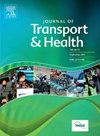Low uptake of driver refresher courses by older adults: An examination of potential explanatory variables using the Candrive cohort
IF 3.2
3区 工程技术
Q2 PUBLIC, ENVIRONMENTAL & OCCUPATIONAL HEALTH
引用次数: 0
Abstract
Introduction
Older drivers benefit from driver refresher courses, particularly courses with on-road training. Yet, the uptake of these courses and the factors associated with taking them is poorly documented.
Methods
We used data from the Candrive prospective cohort (N = 928) to examine these issues using variables representing sociodemographic factors (e.g., age), health-related factors (e.g., medical conditions), and driving-related factors (e.g., driving comfort). The outcome variable was operationalized as having taken a non-mandatory refresher course in the last 10 years or never.
Results
Participants’ mean age was 76.21 (SD = 4.85) and 576 (62.1 %) were males. Ninety-eight participants (10.6 %) reported having taken a non-mandatory refresher course within the last 10 years, and less than half of those reported that it included an on-road component. Only nine percent of participants had discussed driving with a physician. The multivariable regression model (N = 746; −2 log likelihood = 515.10, p < .001, Nagelkerke R2 = 0.12) identified five variables as statistically significant. The odds of having taken a course were higher with age (OR = 1.53, 95 % CI = 1.23, 1.92), when one’s driving was perceived as important for others (OR = 1.87, 95 % CI = 1.26, 2.80), and for participants who spoke to their family (OR = 1.80, 95 % CI = 1.04, 3.09) or to a physician about driving (OR = 2.24, 95 % CI = 1.15, 4.36); the odds were lower for those who benefited the most personally from driving (OR = 0.64, 95 % CI = 0.51, 0.82).
Conclusions
The uptake of driver refresher courses is low and few discussions about driving took place with physicians. Further research is needed to understand the barriers and facilitators related to older drivers’ involvement in refresher courses.
老年人驾驶进修课程的低吸收:使用Candrive队列对潜在解释变量的检查
老司机可从驾驶进修课程,特别是道路训练课程中获益。然而,这些课程的学习情况以及与之相关的因素却鲜有记录。方法:我们使用Candrive前瞻性队列(N = 928)的数据,使用代表社会人口因素(如年龄)、健康相关因素(如医疗状况)和驾驶相关因素(如驾驶舒适度)的变量来检查这些问题。结果变量被操作为在过去10年中参加过非强制性进修课程或从未参加过。结果参与者平均年龄为76.21岁(SD = 4.85),男性576人(62.1%)。98名参与者(10.6%)报告在过去10年内参加了非强制性进修课程,其中不到一半的人报告其中包括道路部分。只有9%的参与者曾与医生讨论过驾驶问题。多变量回归模型(N = 746;−2 log likelihood = 515.10, p <;.001, Nagelkerke R2 = 0.12)确定了五个变量具有统计学意义。当一个人的驾驶被认为对其他人很重要时(OR = 1.87, 95% CI = 1.26, 2.80),以及与家人(OR = 1.80, 95% CI = 1.04, 3.09)或与医生谈论驾驶(OR = 2.24, 95% CI = 1.15, 4.36),参加课程的几率随着年龄的增长而增加(OR = 1.53, 95% CI = 1.23, 1.92);对于那些从驾驶中获益最多的人来说,这种可能性更低(OR = 0.64, 95% CI = 0.51, 0.82)。结论驾驶员进修课程的使用率较低,与医生讨论驾驶相关问题的情况较少。需要进一步的研究来了解与老年驾驶员参与进修课程相关的障碍和促进因素。
本文章由计算机程序翻译,如有差异,请以英文原文为准。
求助全文
约1分钟内获得全文
求助全文

 求助内容:
求助内容: 应助结果提醒方式:
应助结果提醒方式:


